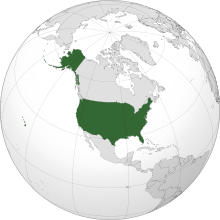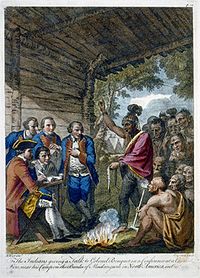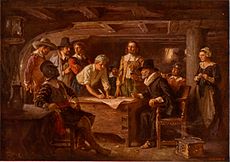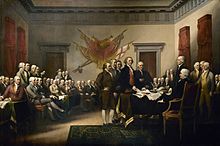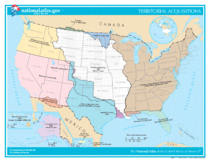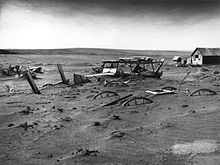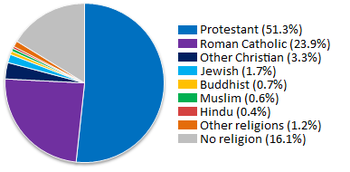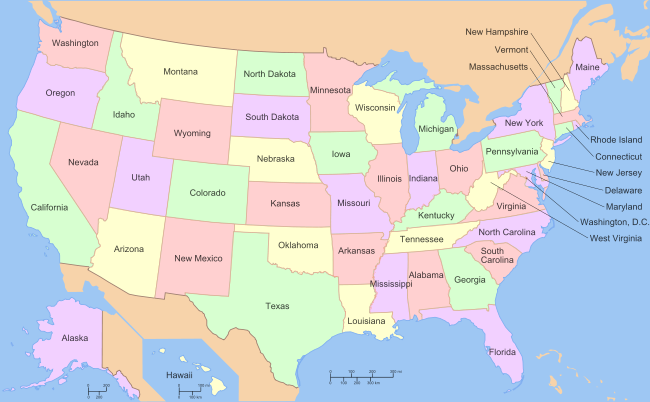
United States
Did you know...
Arranging a Wikipedia selection for schools in the developing world without internet was an initiative by SOS Children. SOS Children has looked after children in Africa for forty years. Can you help their work in Africa?
| United States of America | ||||||
|---|---|---|---|---|---|---|
|
||||||
| Motto: " In God we trust" (official)
|
||||||
| Anthem: " The Star-Spangled Banner" |
||||||
|
|
||||||
| Capital | Washington, D.C. 38°53′N 77°01′W |
|||||
| Largest city | New York City 40°40′N 73°56′W |
|||||
| Official languages | None at federal level | |||||
| National language | English | |||||
| Demonym | American | |||||
| Government | Federal presidential constitutional republic | |||||
| - | President | Barack Obama ( D) | ||||
| - | Vice President | Joe Biden ( D) | ||||
| - | Speaker of the House | John Boehner ( R) | ||||
| - | Chief Justice | John Roberts | ||||
| Legislature | Congress | |||||
| - | Upper house | Senate | ||||
| - | Lower house | House of Representatives | ||||
| Independence from the Kingdom of Great Britain | ||||||
| - | Declared | July 4, 1776 | ||||
| - | Recognized | September 3, 1783 | ||||
| - | Current constitution | June 21, 1788 | ||||
| Area | ||||||
| - | Total | 9,826,675 km2 ( 3rd/4th) 3,794,101 sq mi |
||||
| - | Water (%) | 6.76 | ||||
| Population | ||||||
| - | 2013 estimate | 316,024,000 ( 3rd) | ||||
| - | Density | 34.2/km2 88.6/sq mi |
||||
| GDP ( PPP) | 2012 estimate | |||||
| - | Total | $15.685 trillion ( 1st) | ||||
| - | Per capita | $49,922 ( 6th) | ||||
| GDP (nominal) | 2012 estimate | |||||
| - | Total | $15.685 trillion ( 1st) | ||||
| - | Per capita | $49,922 ( 12th) | ||||
| Gini (2011) | 47.7 high · 39th (2009) |
|||||
| HDI (2013) | very high · 3rd |
|||||
| Currency | United States dollar ($) ( USD) |
|||||
| Time zone | ( UTC−5 to −10) | |||||
| - | Summer ( DST) | ( UTC−4 to −10) | ||||
| Drives on the | right | |||||
| Calling code | +1 | |||||
| ISO 3166 code | [[ISO 3166-2: US| US]] | |||||
| Internet TLD | .us .gov .mil .edu | |||||
| a. | ^ English is the official language of at least 28 states; some sources give higher figures, based on differing definitions of "official". English and Hawaiian are both official languages in the state of Hawaii. | |||||
| b. | ^ English is the de facto language of American government and the sole language spoken at home by 80 percent of Americans aged five and older. Spanish is the second most commonly spoken language. | |||||
| c. | ^ Whether the United States or China is larger is disputed. The figure given is from the U.S. Central Intelligence Agency's The World Factbook. Other sources give smaller figures. All authoritative calculations of the country's size include only the 50 states and the District of Columbia, not the territories. | |||||
| d. | ^ The population estimate is of people whose usual residence is within the 50 states and the District of Columbia, regardless of nationality. It does not include those living in the territories (over 4 million people, mostly in Puerto Rico). | |||||
| e. | ^ See Time in the United States for details about laws governing time zones in the United States. | |||||
| f. | ^ Does not include insular areas and United States Minor Outlying Islands, which have their own ISO 3166 codes. | |||||
| g. | ^ Except US Virgin Islands. | |||||
The United States of America (USA or U.S.A.), commonly called the United States (US or U.S.) and America, is a federal republic consisting of fifty states and a federal district. The 48 contiguous states and the federal district of Washington, D.C. are in central North America between Canada and Mexico. The state of Alaska is west of Canada and east of Russia across the Bering Strait, and the state of Hawaii is in the mid-North Pacific. The country also has five populated and nine unpopulated territories in the Pacific and the Caribbean.
At 3.79 million square miles (9.83 million km2) and with around 315 million people, the United States is the third-or fourth-largest country by total area and the third-largest by both land area and population. It is one of the world's most ethnically diverse and multicultural nations, the product of large-scale immigration from many countries. The geography and climate of the U.S. is also extremely diverse, with deserts, plains, forests, and mountains that are also home to a wide variety of wildlife.
Paleo-indians migrated from Asia to what is now the United States mainland around 12,000 years ago. European colonization began around 1600 and came mostly from England. The United States emerged from thirteen British colonies located along the Atlantic seaboard. Disputes between Great Britain and the American colonies led to the American Revolution. On July 4, 1776, delegates from the thirteen colonies unanimously issued the Declaration of Independence, which established the United States of America. The American Revolutionary War, which ended with the recognition of independence of the United States from the Kingdom of Great Britain, was the first successful war of independence against a European colonial empire. The current Constitution was adopted on September 17, 1787; 27 Amendments have since been added to the Constitution. The first ten amendments, collectively named the Bill of Rights, were ratified in 1791 and guarantee many fundamental civil rights and freedoms.
Driven by the doctrine of manifest destiny, the United States embarked on a vigorous expansion across North America throughout the nineteenth century. This involved displacing native tribes, acquiring new territories, and gradually admitting new states. The American Civil War ended legalized slavery in the United States. By the end of the nineteenth century, the United States extended into the Pacific Ocean, and its economy was the world's largest. The Spanish–American War and World War I confirmed the country's status as a global military power. The United States emerged from World War II as a global superpower, the first country with nuclear weapons, and a permanent member of the United Nations Security Council. The end of the Cold War and the dissolution of the Soviet Union left the United States as the sole superpower.
The United States is a developed country and has the world's largest national economy, with an estimated 2012 GDP of $15.6 trillion – 19% of global GDP at purchasing-power parity, as of 2011. The per capita GDP of the U.S. was the world's sixth-highest as of 2010, although America's income inequality was also ranked highest among OECD countries by the World Bank. The economy is fueled by an abundance of natural resources, a well-developed infrastructure, and high productivity; and while its economy is considered post-industrial it continues to be one of the world's largest manufacturers. The country accounts for 39% of global military spending, being the foremost economic and military power, a prominent political and cultural force in the world, and a leader in scientific research and technological innovation.
Etymology
In 1507, German cartographer Martin Waldseemüller produced a world map on which he named the lands of the Western Hemisphere "America" after Italian explorer and cartographer Amerigo Vespucci.
The first documentary evidence of the phrase "United States of America" was in an anonymously written essay published in The Virginia Gazette newspaper in Williamsburg, Virginia on April 6, 1776. In June 1776, Thomas Jefferson included the phrase "UNITED STATES OF AMERICA" in all capitalized letters in the headline of his "original Rough draught" of the Declaration of Independence. In the final Fourth of July version of the Declaration, the pertinent section of the title was changed to read, "The unanimous Declaration of the thirteen united States of America".
In 1777 the Articles of Confederation announced, "The Stile of this Confederacy shall be 'The United States of America'".
The short form "United States" is also standard. Other common forms include the "U.S.", the "USA", and "America". Colloquial names include the "U.S. of A." and, internationally, the "States". " Columbia", a name popular in poetry and songs of the late 1700s, derives its origin from Christopher Columbus; it appears in the name "District of Columbia".
The standard way to refer to a citizen of the United States is as an " American". "United States", "American" and "U.S." are used to refer to the country adjectivally ("American values", "U.S. forces"). " American" is rarely used in English to refer to subjects not connected with the United States.
The phrase "United States" was originally treated as plural, a description of a collection of independent states—e.g., "the United States are"—including in the Thirteenth Amendment to the United States Constitution, ratified in 1865. It became common to treat it as singular, a single unit—e.g., "the United States is"—after the end of the Civil War. The singular form is now standard; the plural form is retained in the idiom "these United States". The difference has been described as more significant than one of usage, but reflecting the difference between a collection of states and a unit.
In non-English languages, the name is frequently translated as the translation of either the "United States" or "United States of America", and colloquially as "America". In addition, an initialism is sometimes used.
History
Native American and European contact
People from Asia migrated to the North American continent approximately 12,000 or more years ago. Some, such as the pre-Columbian Mississippian culture, developed advanced agriculture, grand architecture, and state-level societies. After European explorers and traders made the first contacts, it is estimated that their population declined due to various reasons, including diseases such as smallpox and measles, intermarriage, and violence.
In the early days of colonization many settlers were subject to shortages of food, disease and attacks from natives. At the same time however many natives and settlers got along and came to depend on each other, especially settlers during the winter months. Natives also came to depend on settlers for guns, ammunition, powder and other modern devices. Because many tribes were frequently at war with one another it became imperative to establish and secure good relationships with at least one group of colonists. As colonists began to spread out into the interior their contact with native Indians increased, sometimes resulting in good relations, oftentimes resulting in conflict. In the process "Native American influenced colonist, and colonist influenced Native American" for better or worse. Natives taught many settlers where, when and how to hunt and fish in the vast frontier that lay before them whose elements were generally unknown to the Europeans. In order to survive settlers often depended on native Indians who taught them how to adopt to the Indian's "hunting culture" and learned the use of animal skins as camouflage, decoys along with various whistles and calls used to attract prey. European ministries and others felt it was important to "civilize" the Indians and urged them to concentrate on farming and ranching and not depend primarily on hunting and gathering. At the same time Indians offered the benefit of their experience in growing corn, an unknown crop in Europe, and using dead fish and other techniques as fertilizer. It was not long before many Indians began to grow new crops and raise livestock and poultry in their communities and made use of the various living utilities settlers had to offer.
Settlements
Following Columbus' discovery of the new world in 1492 other explorers were soon to follow. The first Spanish explorers landed in " La Florida" in 1513. Spain set up settlements in California, Florida, and New Mexico that were eventually merged into the United States. There were also some French settlements along the Mississippi River.
James I on April 10, 1606 chartered The Virginia Company with the purpose of establishing English settlements on the eastern coast of North America. The Virginia Colony was planted in 1607 with Jamestown and the Pilgrims' Plymouth Colony in 1620. Some 100,000 Puritans later settled New England, especially the Massachusetts Bay Colony. Initially the Puritan and Wampanoag were peaceful, however the King Philip's War began following cultural and religious differences between the colonists and the Wampanoag; by the war's end, the European colonists had defeated the Native Americans and were able to expand and control New England. In addition, some New England colonies continued the tradition of African slavery that had existed in Europe since the 1400s and became commercially active in the lucrative " Golden Triangle" African slave trade, involving planters, shippers, and the African tribal chiefs who provided them with slaves.
Beginning in 1614, the Dutch settled in present day New York State; their colony of New Netherland, which had earlier conquered New Sweden, was taken over by England in 1674, but a strong Dutch influence persisted in the Hudson Valley north of New York City for generations. Many new settlers, especially to the South, were indentured servants—some two-thirds of all Virginia settlers between 1630 and 1680. By the turn of the 18th century, African slaves were becoming the primary source of bonded labor in many regions.
Pequot men, women, and children were captured and sold into slavery by the Puritans in New England. The Pequot men were sold to the West Indies, while the women and children remained slaves of the Puritans. In Carolina, Native Americans were captured and sold into slavery to both New England and the West Indies. In 1676, the Virginia colony legally sanctioned the enslavement of Native Americans.
With the 1729 division of the Carolinas and the 1732 colonization of Georgia, the thirteen British colonies that would become the United States of America were established. All had local governments with elections open to most free men, with a growing devotion to the ancient rights of Englishmen and a sense of self-government stimulating support for republicanism. All legalized the African slave trade. With high birth rates, low death rates, and steady settlement, the colonial population grew rapidly. The Christian revivalist movement of the 1730s and 1740s known as the Great Awakening fueled interest in both religion and religious liberty.
In the French and Indian War, British forces seized Canada from the French, but the francophone population remained politically isolated from the southern colonies. Excluding the Native Americans, who were being conquered and displaced, those thirteen colonies had a population of 2.6 million in 1770, about one-third that of Britain. Nearly one-fifth of those living in what would become the United States were black slaves.
Independence and expansion
The American Revolution was the first successful colonial war of independence against a European power. Americans had developed a democratic system of local government and an ideology of "republicanism" that held government rested on the will of the people (not the king), which strongly opposed corruption and demanded civic virtue. They demanded their rights as Englishmen and rejected British efforts to impose taxes without the approval of colonial legislatures. The British insisted and the conflict escalated to full-scale war in 1775, the American Revolutionary War. On June 14, 1775, the Continental Congress, convening in Philadelphia, established a Continental Army under the command of George Washington. Proclaiming that " all men are created equal" and endowed with "certain unalienable Rights", the Congress adopted the Declaration of Independence, drafted largely by Thomas Jefferson, on July 4, 1776. That date is now celebrated annually as America's Independence Day. In 1777, the Articles of Confederation established a weak government that operated until 1789.
After a naval victory followed by the British defeat at Yorktown by American forces assisted by the French, the United States was independent. In the peace treaty of 1783 Britain recognized American sovereignty over most territory east of the Mississippi River. Nationalists calling for a much stronger federal government with powers of taxation led the constitutional convention in 1787. After intense debate in state conventions the United States Constitution was ratified in 1788. The first Senate, House of Representatives, and president—George Washington—took office in 1789. The Bill of Rights, forbidding federal restriction of personal freedoms and guaranteeing a range of legal protections, was adopted in 1791.
Attitudes toward slavery were shifting; nearly all states officially outlawed the international slave trade before the federal government criminalized it in 1808. All the Northern states abolished slavery between 1780 and 1804, leaving the slave states of the South as defenders of the " peculiar institution". With cotton a highly profitable plantation crop after 1820, slave interests in the Southern states maintained that slavery was a positive good for everyone, including the slaves. The Second Great Awakening, beginning about 1800, converted millions to evangelical Protestantism. In the North it energized multiple social reform movements, including abolitionism.
Americans' eagerness to expand westward prompted a long series of Indian Wars. The Louisiana Purchase of French-claimed territory under President Thomas Jefferson in 1803 almost doubled the nation's size. The War of 1812, declared against Britain over various grievances and fought to a draw, strengthened U.S. nationalism. A series of U.S. military incursions into Florida led Spain to cede it and other Gulf Coast territory in 1819.
President Andrew Jackson took office in 1829, and began a set of reforms which led to the era of Jacksonian democracy, which is considered to have lasted from 1830 to 1850. This included many reforms, such as wider male suffrage, and various adjustments to the power of the Federal government. This also led to the rise of the Second Party System, which refers to the dominant parties which existed from 1828 to 1854.
The Trail of Tears in the 1830s exemplified the Indian removal policy that moved Indians to their own reservations, sometimes by force, with small annual government subsidies. The United States annexed the Republic of Texas in 1845, amid a period when the concept of Manifest Destiny was becoming popular. The 1846 Oregon Treaty with Britain led to U.S. control of the present-day American Northwest. The U.S. victory in the Mexican-American War resulted in the 1848 secession of California and much of the present-day American Southwest.
The California Gold Rush of 1848–49 further spurred western migration. New railways made relocation easier for settlers and increased conflicts with Native Americans. Over a half-century, up to 40 million American bison, or buffalo, were slaughtered for skins and meat and to ease the railways' spread. The loss of the buffalo, a primary resource for the plains Indians, was an existential blow to many native cultures. In 1869, President Ulysses S. Grant's Peace policy reversed the previous costly policy of "wars of extermination" in order to civilize and give Indians eventual United State citizenship having incorporated Indians as wards of the state, led by a philanthropic Board of Indian Commissioners.
Civil war and industrialization
During the years leading up to the American Civil War tensions between slave and free states mounted with arguments about the relationship between the state and federal governments, as well as violent conflicts over the spread of slavery into new states. Abraham Lincoln, candidate of the largely antislavery Republican Party, was elected president in 1860. Before he took office, seven slave states declared their secession—which the federal government maintained was illegal—and formed the Confederate States of America.
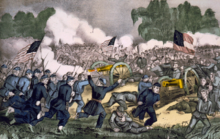 |
 |
|
|
|
|
With the Confederate attack upon Fort Sumter, the Civil War began and four more slave states joined the Confederacy. Lincoln's Emancipation Proclamation in 1863 declared slaves in the Confederacy to be free. Following the Union victory in 1865, three amendments to the U.S. Constitution ensured freedom for the nearly four million African Americans who had been slaves, made them citizens, and gave them voting rights. The war and its resolution led to a substantial increase in federal power. The war remains the deadliest conflict in American history, resulting in the deaths of 620,000 soldiers.
After the war, the assassination of Abraham Lincoln radicalized Republican Reconstruction policies aimed at reintegrating and rebuilding the Southern states while ensuring the rights of the newly freed slaves. President Ulysses S. Grant implemented the Department of Justice and used the U.S. Military to enforce suffrage and civil rights for African Americans in the South destroying the Ku Klux Klan in 1871 under the Force Acts. The resolution of the disputed 1876 presidential election by the Compromise of 1877 ended Reconstruction; Jim Crow laws soon disenfranchised many African Americans.
In the North, urbanization and an unprecedented influx of immigrants from Southern and Eastern Europe hastened the country's industrialization. The wave of immigration, lasting until 1924, provided labor and transformed American culture. United States immigration policies were Eurocentric, which barred Asians from naturalization, and restricted their immigration beginning with the Chinese Exclusion Act in 1882. National infrastructure development spurred economic growth. The end of the Civil War spurred greater settlement and development of the American Old West. This was due to a variety of social and technological developments, including the completion of the First Transcontinental Telegraph in 1861 and the First Transcontinental Railroad in 1869.
The 1867 Alaska Purchase from Russia completed the country's mainland expansion. The Wounded Knee Massacre in 1890 was the last major armed conflict of the Indian Wars. In 1893, the indigenous monarchy of the Pacific Kingdom of Hawaii was overthrown in a coup led by American residents; the United States annexed the archipelago in 1898. Victory in the Spanish–American War the same year demonstrated that the United States was a world power and led to the annexation of Puerto Rico, Guam, and the Philippines. The Philippines gained independence a half-century later; Puerto Rico and Guam remain U.S. territories.
The emergence of many prominent industrialists at the end of the 19th century gave rise to the Gilded Age, a period of growing affluence and power among the business class. This period eventually ended with the beginning of the Progressive Era, a period of great reforms in many societal areas, including regulatory protection for the public, greater antitrust measures, and attention to living conditions for the working classes. President Theodore Roosevelt was one leading proponent of progressive reforms.
World War I, Great Depression, and World War II
At the outbreak of World War I in 1914, the United States remained neutral. Most Americans sympathized with the British and French, although many opposed intervention. In 1917, the United States joined the Allies, and the American Expeditionary Forces helped to turn the tide against the Central Powers. President Woodrow Wilson took a leading diplomatic role at the Paris Peace Conference of 1919 which helped to shape the post-war world. Wilson advocated strongly for the U.S. to join the League of Nations. However, the Senate refused to approve this, and did not ratify the Treaty of Versailles, which established the League of Nations.
The country pursued a policy of unilateralism, verging on isolationism. In 1920, the women's rights movement won passage of a constitutional amendment granting women's suffrage. The prosperity of the Roaring Twenties ended with the Wall Street Crash of 1929 that triggered the Great Depression.
After his election as president in 1932, Franklin D. Roosevelt responded with the New Deal, a range of policies increasing government intervention in the economy, including the establishment of the Social Security system. The Dust Bowl of the mid-1930s impoverished many farming communities and spurred a new wave of western migration.
The United States, effectively neutral during World War II's early stages after Nazi Germany's invasion of Poland in September 1939, began supplying material to the Allies in March 1941 through the Lend-Lease program. On December 7, 1941, the Empire of Japan launched a surprise attack on Pearl Harbour, prompting the United States to join the Allies against the Axis powers as well as the internment of Japanese Americans by the thousands. Participation in the war spurred capital investment and industrial capacity. Among the major combatants, the United States was the only nation to become richer because of the war.
Allied conferences at Bretton Woods and Yalta outlined a new system of international organizations that placed the United States and Soviet Union at the centre of world affairs. As victory was won in Europe, a 1945 international conference held in San Francisco produced the United Nations Charter, which became active after the war. The United States, having developed the first nuclear weapons, used them on the Japanese cities of Hiroshima and Nagasaki in August. Japan surrendered on September 2, ending the war.
Cold War and Civil Rights era
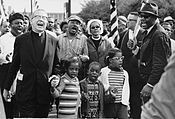 |
 |
|
|
|
|
The United States and the Soviet Union jockeyed for power after World War II during the Cold War, dominating the military affairs of Europe through NATO and the Warsaw Pact, respectively. While they engaged in proxy wars and developed powerful nuclear arsenals, the two countries avoided direct military conflict. The U.S. often opposed Third World left-wing movements that it viewed as Soviet-sponsored. American troops fought Communist Chinese and North Korean forces in the Korean War of 1950–53. The House Un-American Activities Committee pursued a series of investigations into suspected leftist subversion, while Senator Joseph McCarthy became the figurehead of anticommunist sentiment.
The 1961 Soviet launch of the first manned spaceflight prompted President John F. Kennedy's call for the United States to be first to land "a man on the moon", achieved in 1969. Kennedy also faced a tense nuclear showdown with Soviet forces in Cuba. Meanwhile, the United States experienced sustained economic expansion. Amidst the presence of various white nationalist groups, particularly the Ku Klux Klan, a growing civil rights movement used nonviolence to confront segregation and discrimination. This was symbolized and led by black Americans such as Rosa Parks and Martin Luther King, Jr. On the other hand, some black nationalist groups such as the Black Panther Party had a more militant scope.
Following Kennedy's assassination in 1963, the Civil Rights Act of 1964, Voting Rights Act of 1965, and Immigration and Nationality Act of 1965 were passed under President Lyndon B. Johnson. He also signed into law the Medicare and Medicaid programs. Johnson also expanded a proxy war in Southeast Asia into the unsuccessful Vietnam War. A widespread countercultural movement grew, fueled by opposition to the war, black nationalism, and the sexual revolution. Betty Friedan, Gloria Steinem, and others led a new wave of feminism that sought political, social, and economic equality for women.
As president, Richard Nixon ended U.S. involvement in the Vietnam War, improved relations with China, and oversaw the beginning of a period of détente with the Soviet Union. As a result of the Watergate scandal, in 1974 Nixon became the first U.S. president to resign, to avoid being impeached on charges including obstruction of justice and abuse of power. The Jimmy Carter administration of the late 1970s was marked by stagflation and the Iran hostage crisis. The election of Ronald Reagan as president in 1980 heralded a rightward shift in American politics, reflected in major changes in taxation and spending priorities. His second term in office brought both the Iran–Contra scandal and significant diplomatic progress with the Soviet Union. The subsequent Soviet collapse ended the Cold War.
Contemporary era
Under President George H. W. Bush, the United States took a lead role in the UN–sanctioned Gulf War. The longest economic expansion in modern U.S. history—from March 1991 to March 2001—encompassed the Bill Clinton administration and the dot-com bubble. A civil lawsuit and sex scandal led to Clinton's impeachment in 1998, but he remained in office.
The 2000 presidential election, one of the closest in American history, was resolved by a U.S. Supreme Court decision—George W. Bush, son of George H. W. Bush, became president. On September 11, 2001, al-Qaeda terrorists struck the World Trade Centre in New York City and The Pentagon near Washington, D.C., killing nearly three thousand people. In response, the Bush administration launched the global War on Terror, invading Afghanistan and removing the Taliban government and al-Qaeda training camps. Taliban insurgents continue to fight a guerrilla war. In 2003, the United States and several allied forces invaded Iraq to engineer regime change there. In 2005, Hurricane Katrina caused severe destruction along much of the Gulf Coast, devastating New Orleans.
In 2008, amid a global economic recession, the first African American president, Barack Obama, was elected. Major health care and financial system reforms were enacted two years later.
In 2011, a raid by Navy SEALs in Pakistan killed al-Qaeda leader Osama bin Laden. The Iraq War officially ended with the pullout of the remaining U.S. troops from the country in December 2011.
Geography
The land area of the contiguous United States is 2,959,064 square miles (7,663,941 km2). Alaska, separated from the contiguous United States by Canada, is the largest state at 663,268 square miles (1,717,856 km2). Hawaii, occupying an archipelago in the central Pacific, southwest of North America, is 10,931 square miles (28,311 km2) in area.
The United States is the world's third or fourth largest nation by total area (land and water), ranking behind Russia and Canada and just above or below China. The ranking varies depending on how two territories disputed by China and India are counted and how the total size of the United States is measured: calculations range from 3,676,486 square miles (9,522,055 km2) to 3,717,813 square miles (9,629,091 km2) to 3,794,101 square miles (9,826,676 km2). Measured by only land area, the United States is third in size behind Russia and China, just ahead of Canada.
The coastal plain of the Atlantic seaboard gives way further inland to deciduous forests and the rolling hills of the Piedmont. The Appalachian Mountains divide the eastern seaboard from the Great Lakes and the grasslands of the Midwest. The Mississippi–Missouri River, the world's fourth longest river system, runs mainly north–south through the heart of the country. The flat, fertile prairie of the Great Plains stretches to the west, interrupted by a highland region in the southeast.

The Rocky Mountains, at the western edge of the Great Plains, extend north to south across the country, reaching altitudes higher than 14,000 feet (4,300 m) in Colorado. Farther west are the rocky Great Basin and deserts such as the Chihuahua and Mojave. The Sierra Nevada and Cascade mountain ranges run close to the Pacific coast, both ranges reaching altitudes higher than 14,000 feet (4,300 m).
The lowest and highest points in the continental United States are in the state of California, and only about 80 miles (130 km) apart. At 20,320 feet (6,194 m), Alaska's Mount McKinley is the tallest peak in the country and in North America. Active volcanoes are common throughout Alaska's Alexander and Aleutian Islands, and Hawaii consists of volcanic islands. The supervolcano underlying Yellowstone National Park in the Rockies is the continent's largest volcanic feature.
The United States, with its large size and geographic variety, includes most climate types. To the east of the 100th meridian, the climate ranges from humid continental in the north to humid subtropical in the south. The southern tip of Florida is tropical, as is Hawaii. The Great Plains west of the 100th meridian are semi-arid. Much of the Western mountains are alpine. The climate is arid in the Great Basin, desert in the Southwest, Mediterranean in coastal California, and oceanic in coastal Oregon and Washington and southern Alaska. Most of Alaska is subarctic or polar. Extreme weather is not uncommon—the states bordering the Gulf of Mexico are prone to hurricanes, and most of the world's tornadoes occur within the country, mainly in the Midwest's Tornado Alley.
The U.S. ecology is considered " megadiverse": about 17,000 species of vascular plants occur in the contiguous United States and Alaska, and over 1,800 species of flowering plants are found in Hawaii, few of which occur on the mainland. The United States is home to more than 400 mammal, 750 bird, and 500 reptile and amphibian species. About 91,000 insect species have been described.
The Endangered Species Act of 1973 protects threatened and endangered species and their habitats, which are monitored by the United States Fish and Wildlife Service. There are fifty-eight national parks and hundreds of other federally managed parks, forests, and wilderness areas. Altogether, the government owns 28.8% of the country's land area. Most of this is protected, though some is leased for oil and gas drilling, mining, logging, or cattle ranching; 2.4% is used for military purposes.
Demographics
Population
| Race/Ethnicity | |
|---|---|
| (as given by the 2010 Census) | |
| By race: | |
| White | 72.4% |
| Black American | 12.6% |
| Asian | 4.8% |
| American Indian and Alaska Native | 0.9% |
| Native Hawaiian and Pacific Islander | 0.2% |
| Other | 6.2% |
| Multiracial (2 or more) | 2.9% |
| By ethnicity: | |
| Hispanic/Latino (of any race) | 16.3% |
| Non- Hispanic/Latino (of any race) | 83.7% |
The U.S. Census Bureau estimates the country's population now to be 316,024,000, including an approximate 11.2 million illegal aliens. The U.S. population almost quadrupled during the 20th century, from about 76 million in 1900. The third most populous nation in the world, after China and India, the United States is the only major industrialized nation in which large population increases are projected.
With a birth rate of 13 per 1,000, 35% below the world average, its population growth rate is positive at 0.9%, significantly higher than those of many developed nations. In fiscal year 2012, over one million immigrants (most of whom entered through family reunification) were granted legal residence. Mexico has been the leading source of new residents for over two decades; since 1998, China, India, and the Philippines have been in the top four sending countries every year. 9 million Americans identify as lesbian, gay, bisexual or transgender, making up four percent of the population. A 2010 survey found that seven percent of men and eight percent of women identified as gay, lesbian or bisexual.
The United States has a very diverse population—thirty-one ancestry groups have more than one million members. White Americans are the largest racial group; German Americans, Irish Americans, and English Americans constitute three of the country's four largest ancestry groups. Black Americans are the nation's largest racial minority and third largest ancestry group. Asian Americans are the country's second largest racial minority; the three largest Asian American ethnic groups are Chinese Americans, Filipino Americans, and Indian Americans.
In 2010, the U.S. population included an estimated 5.2 million people with some American Indian or Alaska Native ancestry (2.9 million exclusively of such ancestry) and 1.2 million with some native Hawaiian or Pacific island ancestry (0.5 million exclusively). The census counted more than 19 million people of "Some Other Race" who were "unable to identify with any" of its five official race categories in 2010.
The population growth of Hispanic and Latino Americans (the terms are officially interchangeable) is a major demographic trend. The 50.5 million Americans of Hispanic descent are identified as sharing a distinct " ethnicity" by the Census Bureau; 64% of Hispanic Americans are of Mexican descent. Between 2000 and 2010, the country's Hispanic population increased 43% while the non-Hispanic population rose just 4.9%. Much of this growth is from immigration; as of 2007, 12.6% of the U.S. population was foreign-born, with 54% of that figure born in Latin America.
Fertility is also a factor; as of 2010 the average Hispanic (of any race) woman gave birth to 2.35 children in her lifetime, compared to 1.97 for non-Hispanic black women and 1.79 for non-Hispanic white women (both below the replacement rate of 2.1). Minorities (as defined by the Census Bureau as all those beside non-Hispanic, non-multiracial whites) constituted 36.3% of the population in 2010, and over 50% of children under age one, and are projected to constitute the majority by 2042. This contradicts the report by the National Vital Statistics Reports, based on the U.S. census data, which concludes that, 54% (2,162,406 out of 3,999,386 in 2010) of births were non-Hispanic white.
About 82% of Americans live in urban areas (including suburbs); about half of those reside in cities with populations over 50,000. In 2008, 273 incorporated places had populations over 100,000, nine cities had more than one million residents, and four global cities had over two million (New York City, Los Angeles, Chicago, and Houston).
There are fifty-two metropolitan areas with populations greater than one million. Of the fifty fastest-growing metro areas, forty-seven are in the West or South. The metro areas of Dallas, Houston, Atlanta, and Phoenix all grew by more than a million people between 2000 and 2008.
| Leading population centers | |||||||
|---|---|---|---|---|---|---|---|
| Rank | Core city (cities) | Metro area population | Metropolitan Statistical Area | Region |
 New York City  Los Angeles  Chicago |
||
| 1 | New York City | 19,015,900 | New York–New Jersey–Connecticut–Pennsylvania, NY–NJ–CT–PA MSA | Northeast | |||
| 2 | Los Angeles | 12,944,801 | Los Angeles–Long Beach–Santa Ana, CA MSA | West | |||
| 3 | Chicago | 9,504,753 | Chicago–Joliet–Naperville, IL–IN–WI MSA | Midwest | |||
| 4 | Dallas–Fort Worth | 6,526,548 | Dallas–Fort Worth–Arlington, TX MSA | South | |||
| 5 | Houston | 6,086,538 | Houston–The Woodlands-Sugar Land MSA | South | |||
| 6 | Philadelphia | 5,992,414 | Philadelphia–Camden–Wilmington, PA–NJ–DE–MD MSA | Northeast | |||
| 7 | Washington, D.C. | 5,703,948 | Washington, DC–VA–MD–WV MSA | South | |||
| 8 | Miami | 5,670,125 | Miami–Fort Lauderdale–Pompano Beach, FL MSA | South | |||
| 9 | Atlanta | 5,359,205 | Atlanta–Sandy Springs–Marietta, GA MSA | South | |||
| 10 | Boston | 4,591,112 | Boston–Cambridge–Quincy, MA–NH MSA | Northeast | |||
| 11 | San Francisco | 4,391,037 | San Francisco–Oakland–Fremont, CA MSA | West | |||
| 12 | Riverside–San Bernardino | 4,304,997 | Riverside–San Bernandino–Ontario, CA MSA | West | |||
| 13 | Detroit | 4,285,832 | Detroit–Warren–Livonia, MI MSA | Midwest | |||
| 14 | Phoenix | 4,263,236 | Phoenix–Mesa–Glendale, AZ MSA | West | |||
| 15 | Seattle | 3,500,026 | Seattle–Tacoma–Bellevue, WA MSA | West | |||
| 16 | Minneapolis–St. Paul | 3,318,486 | Minneapolis–St. Paul–Bloomington, MN–WI MSA | Midwest | |||
| 17 | San Diego | 3,140,069 | San Diego–Carlsbad–San Marcos, CA MSA | West | |||
| 18 | Tampa–St. Petersburg | 2,824,724 | Tampa–St. Petersburg–Clearwater, FL MSA | South | |||
| 19 | St. Louis | 2,817,355 | St. Louis–St. Charles–Farmington, MO–IL MSA | Midwest | |||
| 20 | Baltimore | 2,729,110 | Baltimore–Towson, MD MSA | South | |||
| based upon 2011 population estimates from the U.S. Census Bureau | |||||||
Language
| Languages (2010) | |
|---|---|
| English (only) | 229.7 million |
| Spanish, incl. Creole | 37.0 million |
| Chinese | 2.8 million |
| French, incl. Creole | 2.1 million |
| Tagalog | 1.6 million |
| Vietnamese | 1.4 million |
| Italian | 1.1 million |
| Korean | 1.1 million |
| German | 1.1 million |
English (American English) is the de facto national language. Although there is no official language at the federal level, some laws—such as U.S. naturalization requirements—standardize English. In 2010, about 230 million, or 80% of the population aged five years and older, spoke only English at home. Spanish, spoken by 12% of the population at home, is the second most common language and the most widely taught second language. Some Americans advocate making English the country's official language, as it is in at least twenty-eight states.
Both Hawaiian and English are official languages in Hawaii, by state law. While neither has an official language, New Mexico has laws providing for the use of both English and Spanish, as Louisiana does for English and French. Other states, such as California, mandate the publication of Spanish versions of certain government documents including court forms. Many jurisdictions with large numbers of non-English speakers produce government materials, especially voting information, in the most commonly spoken languages in those jurisdictions.
Several insular territories grant official recognition to their native languages, along with English: Samoan and Chamorro are recognized by American Samoa and Guam, respectively; Carolinian and Chamorro are recognized by the Northern Mariana Islands; Spanish is an official language of Puerto Rico and is more widely spoken than English there.
Religion
The First Amendment of the U.S. Constitution guarantees the free exercise of religion and forbids Congress from passing laws respecting its establishment. In a 2002 study, 59% of Americans said that religion played a "very important role in their lives", a far higher figure than that of any other wealthy nation. According to a 2007 survey, 78.4% of adults identified themselves as Christian, down from 86.4% in 1990.
Protestant denominations accounted for 51.3%, while Roman Catholicism, at 23.9%, was the largest individual denomination. The total reporting non-Christian religions in 2007 was 4.7%, up from 3.3% in 1990. Other religions include Judaism (1.7%), Islam (0.8%), Buddhism (0.7%), Hinduism (0.4%), and Unitarian Universalism (0.3%). The survey also reported that 16.1% of Americans described themselves as agnostic, atheist, or simply having no religion, up from 8.2% in 1990.
There are also Baha'i, Sikh, Jain, Shinto, Confucian, Taoist, Druid, Native American, Wiccan, humanist and deist communities. Doubt about the existence of a god or gods is growing rapidly among Americans under 30. Polls show that overall American confidence in organized religion is declining, and that younger Americans in particular are becoming increasingly irreligious.
Family structure
In 2007, 58% of Americans age 18 and over were married, 6% were widowed, 10% were divorced, and 25% had never been married. Women now work mostly outside the home and receive a majority of bachelor's degrees.
The U.S. teenage pregnancy rate, 79.8 per 1,000 women, is the highest among OECD nations. While the abortion rate is falling, the abortion ratio of 241 per 1,000 live births and abortion rate of 15 per 1,000 women aged 15–44 remain higher than those of most Western nations.
Government and politics
 |
 |
 |
||
|
|
|
The United States is the world's oldest surviving federation. It is a constitutional republic and representative democracy, "in which majority rule is tempered by minority rights protected by law". The government is regulated by a system of checks and balances defined by the U.S. Constitution, which serves as the country's supreme legal document.
In the American federalist system, citizens are usually subject to three levels of government: federal, state, and local. The local government's duties are commonly split between county and municipal governments. In almost all cases, executive and legislative officials are elected by a plurality vote of citizens by district. There is no proportional representation at the federal level, and it is very rare at lower levels.
The federal government is composed of three branches:
- Legislative: The bicameral Congress, made up of the Senate and the House of Representatives, makes federal law, declares war, approves treaties, has the power of the purse, and has the power of impeachment, by which it can remove sitting members of the government.
- Executive: The president is the commander-in-chief of the military, can veto legislative bills before they become law (subject to Congressional override), and appoints the members of the Cabinet (subject to Senate approval) and other officers, who administer and enforce federal laws and policies.
- Judicial: The Supreme Court and lower federal courts, whose judges are appointed by the president with Senate approval, interpret laws and overturn those they find unconstitutional.
The House of Representatives has 435 voting members, each representing a congressional district for a two-year term. House seats are apportioned among the states by population every tenth year. As of the 2010 census, seven states have the minimum of one representative, while California, the most populous state, has fifty-three.
The Senate has 100 members with each state having two senators, elected at-large to six-year terms; one third of Senate seats are up for election every other year. The president serves a four-year term and may be elected to the office no more than twice. The president is not elected by direct vote, but by an indirect electoral college system in which the determining votes are apportioned to the states and the District of Columbia. The Supreme Court, led by the Chief Justice of the United States, has nine members, who serve for life.
The state governments are structured in roughly similar fashion; Nebraska uniquely has a unicameral legislature. The governor (chief executive) of each state is directly elected. Some state judges and cabinet officers are appointed by the governors of the respective states, while others are elected by popular vote.
The original text of the Constitution establishes the structure and responsibilities of the federal government and its relationship with the individual states. Article One protects the right to the "great writ" of habeas corpus, The Constitution has been amended twenty-seven times; the first ten amendments, which make up the Bill of Rights, and the Fourteenth Amendment form the central basis of Americans' individual rights. All laws and governmental procedures are subject to judicial review and any law ruled in violation of the Constitution is voided. The principle of judicial review, not explicitly mentioned in the Constitution, was declared by the Supreme Court in Marbury v. Madison (1803), a decision handed down by Chief Justice John Marshall.
Political divisions
The United States is a federal union of fifty states. The original thirteen states were the successors of the thirteen colonies that rebelled against British rule. Early in the country's history, three new states were organized on territory separated from the claims of the existing states: Kentucky from Virginia; Tennessee from North Carolina; and Maine from Massachusetts. Most of the other states have been carved from territories obtained through war or purchase by the U.S. government. One set of exceptions includes Vermont, Texas, and Hawaii: each was an independent republic before joining the union. During the American Civil War, West Virginia broke away from Virginia. The most recent state—Hawaii—achieved statehood on August 21, 1959. The states do not have the right to unilaterally secede from the union.
The states compose the vast bulk of the U.S. land mass; the two other areas considered integral parts of the country are the District of Columbia, the federal district where the capital, Washington, is located; and Palmyra Atoll, an uninhabited but incorporated territory in the Pacific Ocean. The United States also possesses five major overseas territories: Puerto Rico and the United States Virgin Islands in the Caribbean; and American Samoa, Guam, and the Northern Mariana Islands in the Pacific. Those born in the major territories are birthright U.S. citizens except Samoans. Samoans born in American Samoa are born U.S. nationals, and may become naturalized citizens. American citizens residing in the territories have fundamental constitutional protections and elective self-government, with a territorial Member of Congress, but they do not vote for president as states. Territories have personal and business tax regimes different from that of states.
The United States also observes tribal sovereignty of the Native Nations. Though reservations are within state borders, the reservation is a sovereign. While the United States recognizes this sovereignty, other countries may not.
Parties and elections

The United States has operated under a two-party system for most of its history. For elective offices at most levels, state-administered primary elections choose the major party nominees for subsequent general elections. Since the general election of 1856, the major parties have been the Democratic Party, founded in 1824, and the Republican Party, founded in 1854. Since the Civil War, only one third-party presidential candidate—former president Theodore Roosevelt, running as a Progressive in 1912—has won as much as 20% of the popular vote. The third-largest political party is the Libertarian Party.
Within American political culture, the Republican Party is considered centre-right or conservative and the Democratic Party is considered centre-left or liberal. The states of the Northeast and West Coast and some of the Great Lakes states, known as " blue states", are relatively liberal. The " red states" of the South and parts of the Great Plains and Rocky Mountains are relatively conservative.
The winner of the 2008 presidential election and the 2012 presidential election, Democrat Barack Obama, is the 44th U.S. president.
In the 113th United States Congress, the House of Representatives is controlled by the Republican Party, while the Democratic Party has control of the Senate. The Senate currently consists of 52 Democrats, two independents who caucus with the Democrats, and 45 Republicans, with one seat vacant; the House consists of 233 Republicans and 201 Democrats, with one seat vacant. There are 30 Republican and 19 Democratic state governors, as well as one independent.
Since the founding of the United States until 2000s, the country's governance has been primarily dominated by White Anglo-Saxon Protestants (WASPs). However, the situation has changed recently and of the top 17 positions (four national candidates of the two major party in the 2012 U.S. presidential election, four leaders in 112th United States Congress, and nine Supreme Court Justices) there is only one WASP.
Foreign relations

The United States has established foreign relations. It is a permanent member of the United Nations Security Council, and New York City hosts the United Nations Headquarters. It is a member of the G8, G20, and Organisation for Economic Co-operation and Development. Almost all countries have embassies in Washington, D.C., and many have consulates around the country. Likewise, nearly all nations host American diplomatic missions. However, Cuba, Iran, North Korea, Bhutan, and the Republic of China (Taiwan) do not have formal diplomatic relations with the United States (although the U.S. still supplies Taiwan with military equipment).
The United States has a " special relationship" with the United Kingdom and strong ties with Canada, Australia, New Zealand, the Philippines, Japan, South Korea, Israel, and several European countries such as France and Germany. It works closely with fellow NATO members on military and security issues and with its neighbors through the Organization of American States and free trade agreements such as the trilateral North American Free Trade Agreement with Canada and Mexico. In 2008, the United States spent a net $25.4 billion on official development assistance, the most in the world. As a share of America's large gross national income (GNI), however, the U.S. contribution of 0.18% ranked last among twenty-two donor states. By contrast, private overseas giving by Americans is relatively generous.
Government finance
Taxes are levied in the United States at the federal, state and local government level. These include taxes on income, payroll, property, sales, imports, estates and gifts, as well as various fees. In 2010 taxes collected by federal, state and municipal governments amounted to 24.8% of GDP. During FY2012, the federal government collected approximately $2.45 trillion in tax revenue, up $147 billion or 6% versus FY2011 revenues of $2.30 trillion. Primary receipt categories included individual income taxes ($1,132B or 47%), Social Security/Social Insurance taxes ($845B or 35%), and corporate taxes ($242B or 10%).
US taxation is generally progressive, especially the federal income taxes, and is among the most progressive in the developed world. In 2009 the top 10% of earners, with 36% of the nation's income, paid 78.2% of the federal personal income tax burden, while the bottom 40% had a negative liability. Payroll taxes are less progressive, as the entitlement programs they ostensibly fund have historically not been viewed as welfare transfers. The top 10% paid 51.8% of total federal taxes in 2009, and the top 1%, with 13.4% of pre-tax national income, paid 22.3% of federal taxes. In 2013 the Tax Policy Centre projected total federal effective tax rates of 35.5% for the top 1%, 27.2% for the top quintile, 13.8% for the middle quintile, and −2.7% for the bottom quintile. State and local taxes vary widely, but are generally less progressive than federal taxes as they rely heavily on broadly borne regressive sales and property taxes that yield less volatile revenue streams, though their consideration doesn’t eliminate the progressive nature of overall taxation.
During FY 2012, the federal government spent $3.54 trillion on a budget or cash basis, down $60 billion or 1.7% vs. FY 2011 spending of $3.60 trillion. Major categories of FY 2012 spending included: Medicare & Medicaid ($802B or 23% of spending), Social Security ($768B or 22%), Defense Department ($670B or 19%), non-defense discretionary ($615B or 17%), other mandatory ($461B or 13%) and interest ($223B or 6%).
Public debt
In March 2013, US federal government debt held by the public was approximately $11.888 trillion, or about 75% of US GDP. Intra-governmental holdings stood at $4.861 trillion, giving a combined total debt of $16.749 trillion. By 2012 total federal debt had surpassed 100% of US GDP. The US has a credit rating of AA+ from Standard & Poor's, AAA from Fitch, and Aaa from Moody's.
Historically, the US public debt as a share of GDP increased during wars and recessions, and subsequently declined. For example, debt held by the public as a share of GDP peaked just after World War II (113% of GDP in 1945), but then fell over the following 30 years. In recent decades, large budget deficits and the resulting increases in debt have led to concern about the long-term sustainability of the federal government's fiscal policies. However, these concerns are not universally shared.
Military
The president holds the title of commander-in-chief of the nation's armed forces and appoints its leaders, the secretary of defense and the Joint Chiefs of Staff. The United States Department of Defense administers the armed forces, including the Army, Navy, Marine Corps, and Air Force. The Coast Guard is run by the Department of Homeland Security in peacetime and the Department of the Navy in time of war. In 2008, the armed forces had 1.4 million personnel on active duty. The Reserves and National Guard brought the total number of troops to 2.3 million. The Department of Defense also employed about 700,000 civilians, not including contractors.
Military service is voluntary, though conscription may occur in wartime through the Selective Service System. American forces can be rapidly deployed by the Air Force's large fleet of transport aircraft, the Navy's eleven active aircraft carriers, and Marine Expeditionary Units at sea with the Navy's Atlantic and Pacific fleets. The military operates 865 bases and facilities abroad, and maintains deployments greater than 100 active duty personnel in 25 foreign countries. The extent of this global military presence has prompted some scholars to describe the United States as maintaining an "empire of bases".
Total U.S. military spending in 2011, more than $700 billion, was 41% of global military spending and equal to the next fourteen largest national military expenditures combined. At 4.7% of GDP, the rate was the second-highest among the top fifteen military spenders, after Saudi Arabia. U.S. defense spending as a percentage of GDP ranks 23rd globally as of 2012 according to the CIA. Defense's share of U.S. spending has generally declined in recent decades, from Cold War peaks of 14.2% of GDP in 1953 and 69.5% of federal outlays in 1954 to 4.7% of GDP and 18.8% of federal outlays in 2011.
The proposed base Department of Defense budget for 2012, $553 billion, is a 4.2% increase over 2011; an additional $118 billion is proposed for the military campaigns in Iraq and Afghanistan. The last American troops serving in Iraq departed in December 2011; 4,484 servicemen were killed during the Iraq War. Approximately 90,000 U.S. troops were serving in Afghanistan as of April 2012; as of May 21, 2013, 2,039 had been killed during the War in Afghanistan.
Law enforcement
Law enforcement in the United States is primarily the responsibility of local police and sheriff's departments, with state police providing broader services. Federal agencies such as the Federal Bureau of Investigation (FBI) and the U.S. Marshals Service have specialized duties. At the federal level and in almost every state, jurisprudence operates on a common law system.
State courts conduct most criminal trials; federal courts handle certain designated crimes as well as certain appeals from the state criminal courts. Federal law prohibits a variety of drugs, although states sometimes pass laws in conflict with federal regulations. The smoking age is generally 18, and the drinking age is generally 21.
Among developed nations, the United States has above-average levels of violent crime and particularly high levels of gun violence and homicide. There were 4.7 murders per 100,000 persons in 2011, 14.5% fewer than in 2000 (5.5), and 19.0% fewer since a recent peak of 5.8 in 2006. Gun ownership rights are the subject of contentious political debate.
The United States has the highest documented incarceration rate and total prison population in the world. At the start of 2008, more than 2.3 million people were incarcerated, more than one in every 100 adults. The current rate is about seven times the 1980 figure, and over three times the figure in Poland, the Organisation for Economic Co-operation and Development (OECD) country with the next highest rate. African American males are jailed at about six times the rate of white males and three times the rate of Hispanic males. The country's high rate of incarceration is largely due to sentencing and drug policies.
Capital punishment is sanctioned in the United States for certain federal and military crimes, and used in thirty-three states. No executions took place from 1967 to 1977, owing in part to a U.S. Supreme Court ruling striking down arbitrary imposition of the death penalty. In 1976, that Court ruled that, under appropriate circumstances, capital punishment may constitutionally be imposed; since the decision there have been more than 1,300 executions, a majority of these taking place in three states: Texas, Virginia, and Oklahoma. Four state legislatures in the modern era have abolished the death penalty, though two of those laws (in New Mexico and Connecticut) were not retroactive. Additionally, state courts in Massachusetts and New York struck down death penalty statutes and their legislatures took no action in response. In 2010, the country had the fifth highest number of executions in the world, following China, Iran, North Korea, and Yemen.
Economy
| Economic indicators | ||
|---|---|---|
| Nominal GDP | 15.864 trillion (Q4 2012) | |
| Real GDP growth | 0.4% (Q4 2012) | |
| 2.2% (2012) | ||
| CPI inflation | 2.0% (February 2012 – February 2013) | |
| Employment-to-population ratio | 58.5% (March 2013) | |
| Unemployment | 7.5% (April 2013) | |
| Labor force participation rate | 63.3% (March 2013) | |
| Poverty | 15.1% (2010) | |
| Public debt | $16.433 trillion (Q4 2012) | |
| Household net worth | $58.5 trillion (Q4 2011) | |
The United States has a capitalist mixed economy, which is fueled by abundant natural resources, a well-developed infrastructure, and high productivity. According to the International Monetary Fund, the U.S. GDP of $15.1 trillion constitutes 22% of the gross world product at market exchange rates and over 19% of the gross world product at purchasing power parity (PPP). Though larger than any other nations, its national GDP was about 5% smaller at PPP in 2011 than the European Union's, whose population is around 62% higher. The country ranks ninth in the world in nominal GDP per capita and sixth in GDP per capita at PPP. The U.S. dollar is the world's primary reserve currency.
The United States is the largest importer of goods and second largest exporter, though exports per capita are relatively low. In 2010, the total U.S. trade deficit was $635 billion. Canada, China, Mexico, Japan, and Germany are its top trading partners. In 2010, oil was the largest import commodity, while transportation equipment was the country's largest export. China is the largest foreign holder of U.S. public debt.

In 2009, the private sector was estimated to constitute 86.4% of the economy, with federal government activity accounting for 4.3% and state and local government activity (including federal transfers) the remaining 9.3%. While its economy has reached a postindustrial level of development and its service sector constitutes 67.8% of GDP, the United States remains an industrial power. The leading business field by gross business receipts is wholesale and retail trade; by net income it is manufacturing.
Chemical products are the leading manufacturing field. The United States is the third largest producer of oil in the world, as well as its largest importer. It is the world's number one producer of electrical and nuclear energy, as well as liquid natural gas, sulfur, phosphates, and salt. While agriculture accounts for just under 1% of GDP, the United States is the world's top producer of corn and soybeans. Coca-Cola and McDonald's are the two most recognized brands in the world.
Consumer spending comprises 71% of the US economy in 2013. In August 2010, the American labor force consisted of 154.1 million people. With 21.2 million people, government is the leading field of employment. The largest private employment sector is health care and social assistance, with 16.4 million people. About 12% of workers are unionized, compared to 30% in Western Europe. The World Bank ranks the United States first in the ease of hiring and firing workers. In 2009, the United States had the third highest labor productivity per person in the world, behind Luxembourg and Norway. It was fourth in productivity per hour, behind those two countries and the Netherlands.
The 2008-2012 global recession had a significant impact on the United States. For example, persistent high unemployment remains, along with low consumer confidence, the continuing decline in home values and increase in foreclosures and personal bankruptcies, an escalating federal debt crisis, inflation, and rising petroleum and food prices. In fact, a 2011 poll found that more than half of all Americans think the U.S. is still in recession or even depression, despite official data that shows a historically modest recovery.
Income, poverty, and wealth
Americans have the highest average household and employee income among OECD nations, and, as of 2007, the second highest median household income, behind only Luxembourg. According to the Census Bureau real median household income was $50,502 in 2011, down from $51,144 in 2010. The Global Food Security Index ranked the US #1 in food affordability and overall food security in March 2013. On average Americans have over twice as much living space per dwelling and per person as Europeans, and more than every European nation.
The US economy is currently embroiled in the economic downturn which followed the Financial crisis of 2007–2008, with output still below potential according to the CBO and unemployment still above historic trends. As of February 2013, the unemployment rate was 7.7% or 12.0 million people, while the government's broader U-6 unemployment rate, which includes the part-time underemployed was 14.3% or 22.2 million. With a record proportion of long term unemployed, continued decreasing household income, tax hikes, and new federal budget cuts, the US economy remained in a jobless recovery. Half of the U.S. population lives in poverty or is low-income, according to U.S. census data.
While inflation-adjusted ("real") household income had been increasing almost every year from 1947 to 1999, it has since been flat and even decreased recently. Extreme poverty in the United States, meaning households living on less than $2 per day before government benefits, doubled from 1996 levels to 1.5 million households in 2011, including 2.8 million children. In 2011 16.7 million children lived in food insecure households, about 35% more than 2007 levels, though only 1.1% of US children, or 845,000, saw reduced food intake or disrupted eating patterns at some point during the year, and most cases weren't chronic. There were about 643,000 sheltered and unsheltered homeless persons in the U.S. in January 2009. Almost two-thirds stayed in an emergency shelter or transitional housing program and the other third were living on the street, in an abandoned building, or another place not meant for human habitation. About 1.56 million people, or about 0.5% of the U.S. population, used an emergency shelter or a transitional housing program between October 1, 2008 and September 30, 2009. The U.S. welfare state is one of the least extensive in the developed world, reducing both relative poverty and absolute poverty by considerably less than the mean for rich nations, though combined private and public social expenditures per capita are relatively high and Americans face much lower consumption taxes than poor Europeans. While the American welfare state effectively reduces poverty among the elderly, it provides relatively little assistance to the young. A 2007 UNICEF study of children's well-being in twenty-one industrialized nations, based on factors like income relative to each nation's own median, self-reported risky behaviour, and family relationship quality, ranked the United States next to last. The share of income of the top 1%—21.8% of total reported income in 2005—has more than doubled since 1980, leaving the United States with the greatest income inequality among developed nations. Poverty in the US has been increasing as median incomes have declined. Analyses using a common data set for comparisons tend to find that the US has a lower absolute poverty rate by market income than most other wealthy nations. Over 80% of poor American households have air conditioning, three quarters own at least one automobile, about 40% own their homes, and the average poor American has more living space than the general population average in every European nation except Luxembourg and Denmark. Most of them have a refrigerator, stove, microwave, telephone, and television. About half have computers and less than half have internet service.

Wealth, like income and taxes, is highly concentrated: The richest 10% of the adult population possesses 69.8% of the country's household wealth, the second-highest share among developed nations. The top 1% possesses 33.4% of net wealth. In 2011 the United Nations Development Programme ranked the United States 23rd among 139 countries on its inequality-adjusted human development index (IHDI), nineteen places lower than in the standard HDI. For the year 2012, the United States ranks 12th on the Legatum Prosperity Index and 19th on the Corruption Perceptions Index. Between June 2007 and November 2008 the global recession led to falling asset prices around the world. Assets owned by Americans lost about a quarter of their value. Since peaking in the second quarter of 2007, household wealth is down $14 trillion. A the end of 2008, household debt amounted to $13.8 trillion. By some measures, the US has more millionaires per capita than any other nation, ranks in the top 14 in billionaires per capita, and has more billionaires and millionaires than any other nation and all of Europe; most of them self-made.
Infrastructure
Transportation
Personal transportation is dominated by automobiles, which operate on a network of 13 million roads, including one of the world's longest highway systems. The world's second largest automobile market, the United States has the highest rate of per-capita vehicle ownership in the world, with 765 vehicles per 1,000 Americans. About 40% of personal vehicles are vans, SUVs, or light trucks. The average American adult (accounting for all drivers and non-drivers) spends 55 minutes driving every day, traveling 29 miles (47 km).
Mass transit accounts for 9% of total U.S. work trips. While transport of goods by rail is extensive, relatively few people use rail to travel, though ridership on Amtrak, the national intercity passenger rail system, grew by almost 37% between 2000 and 2010. Also, light rail development has increased in recent years. Bicycle usage for work commutes is minimal.
The civil airline industry is entirely privately owned and has been largely deregulated since 1978, while most major airports are publicly owned. The three largest airlines in the world by passengers carried are U.S.-based; American Airlines is number one after its 2013 acquisition of US Airways. Of the world's thirty busiest passenger airports, sixteen are in the United States, including the busiest, Hartsfield-Jackson Atlanta International Airport.
Energy
The United States energy market is 29,000 terawatt hours per year. Energy consumption per capita is 7.8 tons of oil equivalent per year, the 10th highest rate in the world. In 2005, 40% of this energy came from petroleum, 23% from coal, and 22% from natural gas. The remainder was supplied by nuclear power and renewable energy sources. The United States is the world's largest consumer of petroleum. For decades, nuclear power has played a limited role relative to many other developed countries, in part because of public perception in the wake of a 1979 accident. In 2007, several applications for new nuclear plants were filed. The United States has 27% of global coal reserves. It is the world's largest producer of natural gas and crude oil.
Science and technology

The United States has been a leader in scientific research and technological innovation since the late 19th century. In 1876, Alexander Graham Bell was awarded the first U.S. patent for the telephone. Thomas Edison's laboratory developed the phonograph, the first long-lasting light bulb, and the first viable movie camera. Nikola Tesla pioneered alternating current, the AC motor, and radio. In the early 20th century, the automobile companies of Ransom E. Olds and Henry Ford popularized the assembly line. The Wright brothers, in 1903, made the first sustained and controlled heavier-than-air powered flight.
The rise of Nazism in the 1930s led many European scientists, including Albert Einstein, Enrico Fermi, and John von Neumann, to immigrate to the United States. During World War II, the Manhattan Project developed nuclear weapons, ushering in the Atomic Age. The Space Race produced rapid advances in rocketry, materials science, and computers. IBM, Apple Computer, and Microsoft refined and popularized the personal computer.
The United States largely developed the ARPANET and its successor, the Internet. Today, 64% of research and development funding comes from the private sector. The United States leads the world in scientific research papers and impact factor. As of April 2010, 77% of American households owned at least one computer, and 68% had broadband Internet service. 85% of Americans also own a mobile phone as of 2011. The country is the primary developer and grower of genetically modified food, representing half of the world's biotech crops.
Education

American public education is operated by state and local governments, regulated by the United States Department of Education through restrictions on federal grants. In most states, children are required to attend school from the age of six or seven (generally, kindergarten or first grade) until they turn eighteen (generally bringing them through twelfth grade, the end of high school); some states allow students to leave school at sixteen or seventeen. About 12% of children are enrolled in parochial or nonsectarian private schools. Just over 2% of children are homeschooled.
The United States has many competitive private and public institutions of higher education. According to prominent international rankings, 13 or 15 American colleges and universities are ranked among the top 20 in the world. There are also local community colleges with generally more open admission policies, shorter academic programs, and lower tuition. Of Americans twenty-five and older, 84.6% graduated from high school, 52.6% attended some college, 27.2% earned a bachelor's degree, and 9.6% earned graduate degrees. The basic literacy rate is approximately 99%. The United Nations assigns the United States an Education Index of 0.97, tying it for 12th in the world.
Health

The United States life expectancy of 78.4 years at birth ranks it 50th among 221 nations. Increasing obesity in the United States and health improvements elsewhere have contributed to lowering the country's rank in life expectancy from 1987, when it was 11th in the world. Obesity rates in the United States are among the highest in the world. Approximately one-third of the adult population is obese and an additional third is overweight; the obesity rate, the highest in the industrialized world, has more than doubled in the last quarter-century. Obesity-related type 2 diabetes is considered epidemic by health care professionals. The infant mortality rate of 6.06 per thousand places the United States 176th highest out of 222 countries.
The U.S. is a global leader in medical innovation. America solely developed or contributed significantly to 9 of the top 10 most important medical innovations since 1975 as ranked by a 2001 poll of physicians, while the EU and Switzerland together contributed to five. Since 1966 Americans have received more Nobel Prizes in Medicine than the rest of the world combined. From 1989 to 2002 four times more money was invested in private biotechnology companies in America than in Europe.
The U.S. health-care system far outspends any other nations, measured in both per capita spending and percentage of GDP. In 2008, the US spent more on health care per capita ($7,146), and as percentage of GDP (15.2%), than any other nation. Health-care coverage in the United States is a combination of public and private efforts, and is not universal as in all other developed countries. In 2004, private insurance paid for 36% of personal health expenditures, private out-of-pocket payments covered 15%, and federal, state, and local governments paid for 44%.
In 2010, 49.9 million residents or 16.3% of the population did not carry health insurance. The main cause of this rise is the drop in the number of Americans with employer-sponsored health insurance. The subject of uninsured and underinsured Americans is a major political issue. In 2006, Massachusetts became the first state to mandate universal health insurance. In 2007, 62.1% of filers for bankruptcy blamed medical expenses. About 25% of all senior citizens declare bankruptcy because of medical expenses, and 43% are forced to mortgage or sell their primary residence. Federal legislation passed in early 2010 would ostensibly create a near-universal health insurance system around the country by 2014, though the bill and its ultimate impact are issues of controversy.
Culture

The United States is a multicultural nation, home to a wide variety of ethnic groups, traditions, and values. Aside from the relatively small Native American and Native Hawaiian populations, nearly all Americans or their ancestors settled or immigrated within the past five centuries. Mainstream American culture is a Western culture largely derived from the traditions of European immigrants with influences from many other sources, such as traditions brought by slaves from Africa. More recent immigration from Asia and especially Latin America has added to a cultural mix that has been described as both a homogenizing melting pot, and a heterogeneous salad bowl in which immigrants and their descendants retain distinctive cultural characteristics.
American culture is considered the most individualistic in the world. The American Dream, or the perception that Americans enjoy high social mobility, plays a key role in attracting immigrants. By some measures social mobility is actually lower than other high-income countries such as France, Germany, Canada, Australia, and the Nordic countries, though such studies are based on relative comparisons within each nation rather than absolute wealth earned throughout one's life, the US having both a more stretched out income distribution and a higher median income than those nations. While the mainstream culture holds that the United States is a classless society, scholars identify significant differences between the country's social classes, affecting socialization, language, and values.
The American middle and professional class has initiated many contemporary social trends such as modern feminism, environmentalism, and multiculturalism. Americans' self-images, social viewpoints, and cultural expectations are associated with their occupations to an unusually close degree. While Americans tend greatly to value socioeconomic achievement, being ordinary or average is generally seen as a positive attribute.
Literature, philosophy, and the arts
In the 18th and early 19th centuries, American art and literature took most of its cues from Europe. Writers such as Nathaniel Hawthorne, Edgar Allan Poe, and Henry David Thoreau established a distinctive American literary voice by the middle of the 19th century. Mark Twain and poet Walt Whitman were major figures in the century's second half; Emily Dickinson, virtually unknown during her lifetime, is now recognized as an essential American poet. A work seen as capturing fundamental aspects of the national experience and character—such as Herman Melville's Moby-Dick (1851), Twain's The Adventures of Huckleberry Finn (1885), and F. Scott Fitzgerald's The Great Gatsby (1925)—may be dubbed the " Great American Novel".

Eleven U.S. citizens have won the Nobel Prize in Literature, most recently Toni Morrison in 1993. William Faulkner and Ernest Hemingway are often named among the most influential writers of the 20th century. Popular literary genres such as the Western and hardboiled crime fiction developed in the United States. The Beat Generation writers opened up new literary approaches, as have postmodernist authors such as John Barth, Thomas Pynchon, and Don DeLillo.
The transcendentalists, led by Thoreau and Ralph Waldo Emerson, established the first major American philosophical movement. After the Civil War, Charles Sanders Peirce and then William James and John Dewey were leaders in the development of pragmatism. In the 20th century, the work of W. V. O. Quine and Richard Rorty, and later Noam Chomsky, brought analytic philosophy to the fore of American philosophical academia. John Rawls and Robert Nozick led a revival of political philosophy. Cornel West and Judith Butler have led a continental tradition in American philosophical academia. Globally influential Chicago school economists like Milton Friedman, James M. Buchanan, and Thomas Sowell have transcended discipline to impact various fields in social and political philosophy.
In the visual arts, the Hudson River School was a mid-19th-century movement in the tradition of European naturalism. The realist paintings of Thomas Eakins are now widely celebrated. The 1913 Armory Show in New York City, an exhibition of European modernist art, shocked the public and transformed the U.S. art scene. Georgia O'Keeffe, Marsden Hartley, and others experimented with new, individualistic styles. Major artistic movements such as the abstract expressionism of Jackson Pollock and Willem de Kooning and the pop art of Andy Warhol and Roy Lichtenstein developed largely in the United States. The tide of modernism and then postmodernism has brought fame to American architects such as Frank Lloyd Wright, Philip Johnson, and Frank Gehry.

One of the first major promoters of American theatre was impresario P. T. Barnum, who began operating a lower Manhattan entertainment complex in 1841. The team of Harrigan and Hart produced a series of popular musical comedies in New York starting in the late 1870s. In the 20th century, the modern musical form emerged on Broadway; the songs of musical theatre composers such as Irving Berlin, Cole Porter, and Stephen Sondheim have become pop standards. Playwright Eugene O'Neill won the Nobel literature prize in 1936; other acclaimed U.S. dramatists include multiple Pulitzer Prize winners Tennessee Williams, Edward Albee, and August Wilson.
Though little known at the time, Charles Ives's work of the 1910s established him as the first major U.S. composer in the classical tradition, while experimentalists such as Henry Cowell and John Cage created a distinctive American approach to classical composition. Aaron Copland and George Gershwin developed a new synthesis of popular and classical music. Choreographers Isadora Duncan and Martha Graham helped create modern dance, while George Balanchine and Jerome Robbins were leaders in 20th-century ballet. Americans have long been important in the modern artistic medium of photography, with major photographers including Alfred Stieglitz, Edward Steichen, and Ansel Adams. The newspaper comic strip and the comic book are both U.S. innovations. Superman, the quintessential comic book superhero, has become an American icon.
Food
Mainstream American cuisine is similar to that in other Western countries. Wheat is the primary cereal grain. Traditional American cuisine uses indigenous ingredients, such as turkey, venison, potatoes, sweet potatoes, corn, squash, and maple syrup, which were consumed by Native Americans and early European settlers.
Slow-cooked pork and beef barbecue, crab cakes, potato chips, and chocolate chip cookies are distinctively American foods. Soul food, developed by African slaves, is popular around the South and among many African Americans elsewhere. Syncretic cuisines such as Louisiana Creole, Cajun, and Tex-Mex are regionally important.
Characteristic dishes such as apple pie, fried chicken, pizza, hamburgers, and hot dogs derive from the recipes of various immigrants. French fries, Mexican dishes such as burritos and tacos, and pasta dishes freely adapted from Italian sources are widely consumed. Americans generally prefer coffee to tea. Marketing by U.S. industries is largely responsible for making orange juice and milk ubiquitous breakfast beverages.
The American fast food industry, the world's largest, pioneered the drive-through format in the 1930s. Fast food consumption has sparked health concerns. During the 1980s and 1990s, Americans' caloric intake rose 24%; frequent dining at fast food outlets is associated with what public health officials call the American " obesity epidemic". Highly sweetened soft drinks are widely popular, and sugared beverages account for nine percent of American caloric intake.
Sports

Baseball has been regarded as the national sport since the late 19th century, while American football is now by several measures the most popular spectator sport. Basketball and ice hockey are the country's next two leading professional team sports. These four major sports, when played professionally, each occupy a season at different, but overlapping, times of the year. College football and basketball attract large audiences. Boxing and horse racing were once the most watched individual sports, but they have been eclipsed by golf and auto racing, particularly NASCAR. In the 21st century, televised mixed martial arts has also gained a strong following of regular viewers. While soccer is much less popular in the United States than in many other nations, it is played widely at the youth and amateur levels; even so, the men's team has been to the past six World Cups and the women are #1 in the women's world rankings. Tennis and many outdoor sports are popular as well.
While most major U.S. sports have evolved out of European practices, basketball, volleyball, skateboarding, snowboarding, and cheerleading are American inventions, which have become popular in other countries. Lacrosse and surfing arose from Native American and Native Hawaiian activities that predate Western contact. Eight Olympic Games have taken place in the United States. The United States has won 2,301 medals at the Summer Olympic Games, more than any other country, and 253 in the Winter Olympic Games, the second most by 2006.


